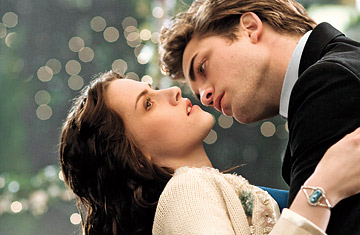
Edward (Pattinson) moves on Bella (Stewart) for the kill — sorry, the kiss
(2 of 2)
For any author of imaginist fiction, from J.R.R. Tolkien to George Lucas, from Rowling to Meyer, the fun is in creating the laws, folkways and architecture of the alternative universe that its more fanciful characters inhabit. The Cullens are a fastidious family of vampires; in their tennis whites, with their regal airs, they resemble the aristocratic Flyte brood in Brideshead Revisited. They call themselves vegetarians because they drink the blood of animals, not people. They can fly, move with lightning speed, scale trees in a trice. They also play baseball, which in the Cullen clan is a lot like Rowling's Quidditch. Their ball-playing, and the scent of human snack food, will attract the notice of a trio of rogue vampires, whose leader, James (Cam Gigandet), is a demon simulacrum of the angelic Edward.
Falling in Love with Love, Again
Twilight also observes movie laws as aged as Edward, who was initiated into the realm of the undead in 1918. Defiantly old-fashioned, the film wants viewers to believe not so much in vampires as in the existence of an anachronistic movie notion: a love that is convulsive and ennobling. Bella could be any Hollywood heroine in love with a good boy whom society callously misunderstands. She's Natalie Wood to Edward's James Dean (in Rebel Without a Cause) or Richard Beymer (in West Side Story). Cathy, meet Heathcliff. Juliet, Romeo.
This brand of fervid romance packed 'em in for the first 60 years of feature films, then went nearly extinct, replaced by the young-male fetishes of space toys and body-function humor. Twilight says to heck with that. It jettisons facetiousness for a liturgical solemnity, and hardware for soft lips. It revives the precept that there's nothing more cinematic than a close-up of two beautiful people about to kiss. The movie's core demographic is so young, its members may not know how uncool this tendency has become. But for them, uncool is hot. And seeing Twilight is less a trip to the multiplex than a pilgrimage to the Lourdes of puberty. It's the girls' first blast of movie estrogen.
Hardwicke, who directed the teen outsider films Thirteen, Lords of Dogtown and The Nativity Story (another fable about a special girl with a condition that's hard to explain), is no great shakes as an auteur. She dawdles in sketching Bella's high school chums, and her direction of the dialogue will often bore those who aren't mouthing it from memory as the actors speak it. But she chose her leads wisely: the pretty Stewart is a questioning, questing presence; the Brit Pattinson, a sensitive-stud dreamboat. And Hardwicke is faithful to the book's chaste eroticism. The couple must put off having sex because, well, it could kill Bella. (aids metaphors are unavoidable here.) Yet waiting has its own delicious tension.
So Twilight isn't a masterpiece--no matter. It rekindles the warmth of great Hollywood romances, where foreplay was the climax and a kiss was never just a kiss.
